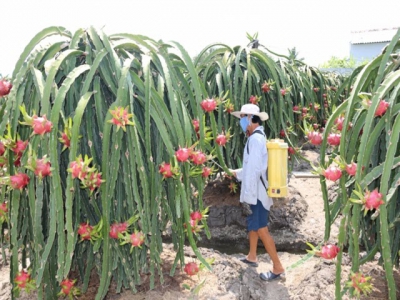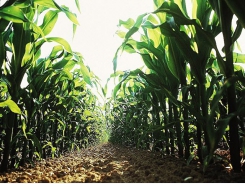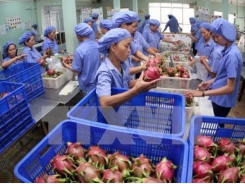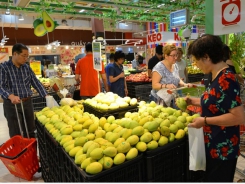The sustainable development of fruit trees in southern provinces

According to the orientation of the Ministry of Agriculture and Rural Development, fruit tree development will continue to be promoted in order to make full use of and exploit potentials, available advantages and raise revenues. That eradicates hunger and reduces poverty and enriches farmers, especially in poor rural areas and difficulties areas. At the same time, it contributes to socio-economic growth in many local regions and Vietnam's agricultural growth.
The fruit and vegetable industry’s continuous export surpluses over many years. Photo: N.Hien
On March 15, in Long An province, Ministry of Agriculture and Rural Development held a conference to promote sustainable development of fruit trees in the southern provinces.
The low processing proportion
According to the report of the Ministry of Agriculture and Rural Development, the acreage of fruit trees in the southern provinces has been growing continuously in recent years, up to now it is estimated at 596,331 hectares, accounting for 60% of the area of fruit production in the country, with a total output of more than 6.6 million tons, accounting for about 67% of the country's output.
At this time, there are 14 types of fruit in the south with a large area of over 10,000 ha/type, of which the largest is the mango area (80,000 ha), bananas (78,000 ha), dragon fruits (53,000 ha), oranges and pomelos (44,000 ha), longan (35,000 ha), durian (47,000 ha), pineapple (33,000 ha) ... However, the area of fruit trees is scattered so it is very difficult for infrastructure investments and groups functional production link and product quality control. At present, there are only a few types of fruits such as banana, dragon fruits and citrus trees that are forming concentrated production areas and specializing in large-scale cultivation.
Currently, there are about 145 industrial vegetable and fruit processing establishments with a total designed capacity of over 800,000 tons of products/ year. However, processed fruits are few in terms of types and yields. Particularly in the South, there are 71 processing facilities, but most processing factories are in shortage of raw materials, the actual capacity is only about 50% of designed capacity.
The processed products currently consist of; canned food (pineapple, juice ...), frozen (pineapple, durian ...), freeze dried, plastic chips, salt ..., in which the proportion of canned products accounted for 50%.
Most of the processing factories are small and medium scale, without material areas, the linkage between production, preservation and processing is limited, it can’t ensure the quality and quantity of raw material areas. In addition, products are processed in crude form, low quality, high risk of unsafe food. The investment and innovation of processing technology of factories is still slow, these do not meet the increasing demands of customers, especially fastidious markets such as Japan, EU, and US...
Maintaining sustainable trade surplus
In the past 10 years, Vietnam’s export value of vegetables and fruits has increased rapidly with an average annual growth rate of 25.8%. Accordingly, the import-export balance also increased rapidly over the years from 200 million USD in 2008 to over 2 billion USD in 2018, an average growth rate of 33.6% / year.
Although there is an increase in imports to diversify domestic market demand, however, due to the strong growth in exports, the fruit and vegetable industry has been continuously increasing for many years. Specifically, the export and import balance of fruits and vegetables has always been positive from less than USD 500 million per year (from 2008 to 2012) to USD 966 million in 2014 and exceeded USD 1 billion from 2015 (USD 1.2 billion) 2018 reached over $ 2 billion.
Along with the growth in turnover, the export markets for large fruits and vegetables were also expanded. In 2004, there were 13 export markets valued at over US $ 1 million. By 2018, there are 13 major export markets worth over USD 25 million. Besides China is the largest market (accounting for 73% market share), and many kinds of vegetables and fruits in our country have been exported to difficult markets: America (3.7%), South Korea (3.0%), Japan (2.8%), the Netherlands (1.6%); followed by Malaysia, Thailand, Australia, Taiwan, United Arab Emirates (all accounted for over 1%).
According to the orientation of the agricultural sector, acreage of a number of key fruit trees with export value such as bananas, mangoes, pineapples and longan ... will be expanded in order to serve domestic consumption demand well, decrease imports and increase exports. According to the plan, by 2020, the value of vegetables and fruits export will reach over 4.5 billion USD, of which fruit products account for over 3.6 billion USD. By 2030, the value of fruit and vegetable exports is over 7 billion USD, of which the export value of fruits is over 6 billion USD, maintaining the trade balance between export and import of over 1.5 billion USD.
Achieving that result, the Ministry of Agriculture and Rural Development proposed the Government and ministries and agencies to have policies for encouraging investment in fruit processing facilities, such as irradiation, steam treatment.., facilitating export enterprises to expand their markets.
In addition, support, exemption and reduction of taxes, warehousing and transportation charges for fresh fruit consumption; review, maximum support procedures, minimize the time from post-harvest handling, packaging, checking and transporting fresh export fruits and vegetables via air.
The State should continue to pay attention to trade promotion, actively negotiate with countries to expand export markets, directing Vietnamese trade agencies abroad to promote connection activities, creating conditions for enterprises to understand the market and sign contracts for Vietnamese fruit consumption.
Có thể bạn quan tâm
Phần mềm

Phối trộn thức ăn chăn nuôi

Pha dung dịch thủy canh

Định mức cho tôm ăn

Phối trộn phân bón NPK

Xác định tỷ lệ tôm sống

Chuyển đổi đơn vị phân bón

Xác định công suất sục khí

Chuyển đổi đơn vị tôm

Tính diện tích nhà kính

Tính thể tích ao hồ



 Southern provinces replace crops on ineffective rice growing…
Southern provinces replace crops on ineffective rice growing…  Vietnamese mangoes on the go: US licenses imports
Vietnamese mangoes on the go: US licenses imports